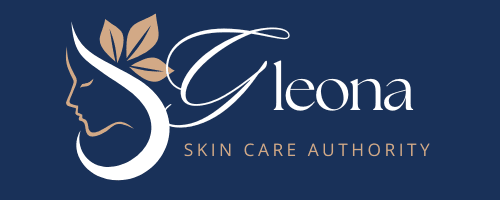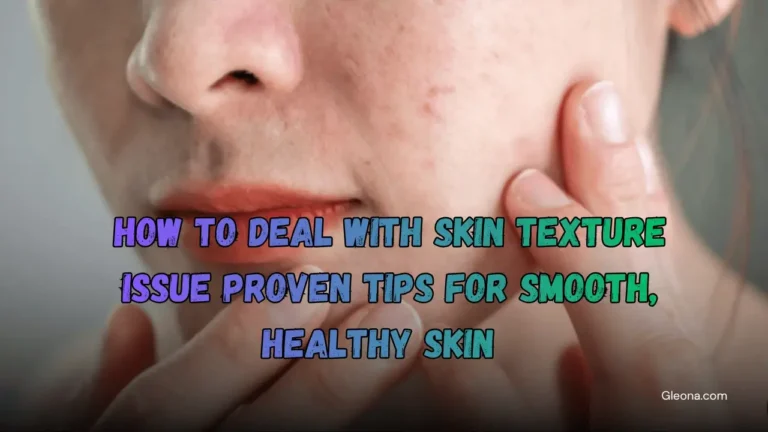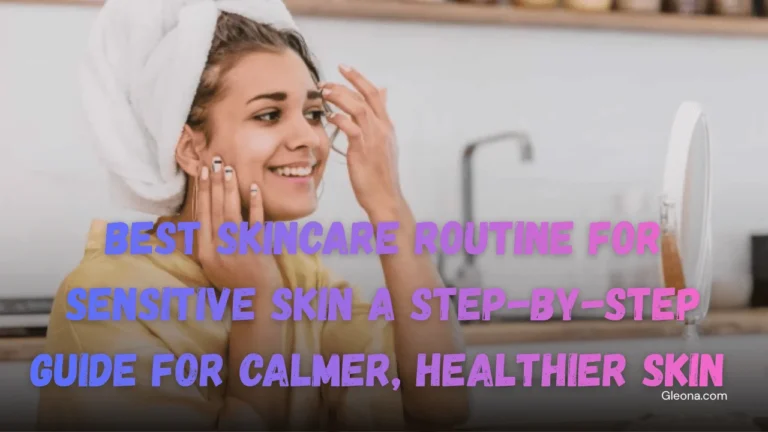Hormonal acne isn’t just a skin issue it’s often a sign that your body, hormones, and inner well-being may be asking for more balance. Breakouts along the jawline or chin, sudden flare-ups during stressful moments, or monthly cycle–related acne can affect confidence and self-esteem. Instead of harsh treatments that strip the skin or cause irritation, many people are now embracing a gentler, more holistic path to healing that supports the skin from the inside out.
Discover how to treat hormonal acne naturally with holistic skincare, calming botanicals, and lifestyle tips that balance hormones for clearer, glowing skin.
This guide is designed to help you reconnect with your skin through natural, mindful practices that nurture overall wellness. You’ll learn how to treat hormonal acne naturally with soothing botanical ingredients, hormone-balancing foods, and simple self-care rituals that encourage harmony between the body, mind, and skin. With patience, consistency, and a more holistic approach, clearer and more radiant skin becomes not just possible but sustainable.
What Is Hormonal Acne?

Hormonal acne is a type of acne triggered by fluctuations in the body’s hormones particularly androgens, cortisol, and reproductive hormones like estrogen and progesterone. These imbalances can cause the skin’s oil glands to produce excess sebum, leading to clogged pores, inflammation, and recurring breakouts. Unlike occasional pimples, hormonal acne often appears in cycles and tends to be more persistent and harder to treat with conventional over-the-counter products.
Most people notice hormonal acne around the jawline, chin, lower cheeks, neck, and sometimes the back or chest. It can show up as whiteheads, painful deep cysts, or inflamed bumps. While it’s commonly associated with puberty, adults especially those aged 18–35 experience it due to lifestyle, stress, and internal health patterns. For many, hormonal acne is the skin’s way of signaling that something inside the body needs support and balance.
Why Choose Natural Remedies for Hormonal Acne?
Choosing natural remedies to treat hormonal acne is about more than clearing breakouts it’s about nurturing your body and supporting long-term skin harmony. Many conventional acne treatments rely on strong chemicals that can strip the skin, disrupt the moisture barrier, or cause side effects like dryness, irritation, or sensitivity. Natural approaches, on the other hand, work gently with your skin’s biology, aiming to rebalance hormones, calm inflammation, and support healing from within.
A holistic approach honors the connection between mind, body, and skin. Natural remedies often focus on the root causes of hormonal acne such as stress, diet, gut health, and lifestyle rather than just treating the surface symptoms. Herbal botanicals, plant-based skincare, and nourishing foods carry anti-inflammatory and hormone-supportive properties that help bring the skin back into balance. With consistency and mindful care, natural treatments can create more sustainable, radiant results without overwhelming the skin or body.
Natural Skincare Routine to Treat Hormonal Acne (Step-by-Step Tutorial)

Caring for hormonal acne naturally is about choosing gentle, non-toxic products that calm inflammation, balance oil production, and support the skin barrier. Consistency matters more than complicated routines focus on clean, skin-loving ingredients that soothe and restore harmony.
Morning Routine for Hormonal Acne (AM)
Start your day with a routine that refreshes, protects, and balances the skin.
1. Gentle Cleanser (No Sulfates or Fragrance)
Use a mild, pH-balanced cleanser to remove oil that accumulates overnight without stripping natural moisture.
2. Hydrating Toner or Mist (Optional)
Aloe vera, rose water, or green tea mist can soothe redness and prep the skin for nourishment.
3. Balancing Serum: Niacinamide or Vitamin B3
Helps regulate oil production, minimize pores, and reduce inflammation great for hormonal acne-prone skin.
4. Lightweight Moisturizer (Non-Comedogenic)
Choose a gel-based or water-cream formula with ingredients like aloe, squalane, or ceramides.
5. Mineral Sunscreen (Zinc Oxide Preferred)
Zinc offers sun protection and anti-inflammatory benefits that help acne heal faster.
Night Routine for Hormonal Acne (PM)
Evening care helps cleanse the skin deeply and support overnight renewal.
1. Double Cleanse
- Step 1: Use a natural oil cleanser (jojoba or grapeseed) to remove SPF and makeup.
- Step 2: Follow with a gentle foaming cleanser to cleanse without irritation.
2. Natural Treatment or Serum
Choose one per night to avoid irritation:
- Salicylic Acid (BHA) – unclogs pores and reduces breakouts
- Tea Tree Oil (diluted) – antibacterial and calming
- Bakuchiol (Natural Retinol Alternative) – supports cell renewal without harshness
3. Soothing Moisturizer
Look for ingredients like aloe vera, chamomile, blue tansy, or centella asiatica to calm redness and support the skin barrier.
4. Spot Treatment (Only if Needed)
Apply to active breakouts: diluted tea tree oil, sulfur, or a dab of turmeric + aloe gel.
Weekly Rituals (1–2 Times a Week)
These practices offer deeper detox and self-care to restore balance.
• Clay Mask (Kaolin or Bentonite)
Draws out impurities and excess oil without stripping the skin.
• Green Tea or Herbal Steam
Adds antioxidants, opens pores gently, and supports circulation.
• Turmeric & Honey Calming Mask
A holistic anti-inflammatory treatment to soothe swelling and support healing.
Holistic Skincare Tips for Best Results
- Avoid harsh scrubs or over-exfoliating this can worsen inflammation.
- Keep skincare minimal and consistent for at least 3–4 weeks before changing products.
- Patch-test natural oils or herbal ingredients to avoid sensitivity.
Best Natural Ingredients That Help Treat Hormonal Acne
Nature offers powerful botanicals that soothe inflammation, balance oil production, and support hormonal harmony from the inside out. When used consistently and correctly, these ingredients can help calm breakouts, minimize redness, and promote clearer, healthier skin without harsh chemicals or irritation.
1. Tea Tree Oil – Natural Antibacterial & Acne Fighter

Tea tree oil is a well-known natural remedy for acne due to its strong antibacterial and anti-inflammatory properties. It helps reduce bacteria on the skin, shrink active breakouts, and soothe redness.
How to Use: Dilute 1–2 drops in a carrier oil (like jojoba or aloe gel) before applying as a spot treatment.
Best For: Inflamed pimples, occasional cysts, spot treatment.
2. Aloe Vera – Calming & Skin Barrier Support

Aloe vera is rich in vitamins, antioxidants, and enzymes that help calm irritation, reduce inflammation, and support skin healing. It’s especially helpful for sensitive or inflamed hormonal acne.
How to Use: Apply a thin layer of pure aloe gel as a moisturizer or mix with turmeric for a calming mask.
Best For: Redness, swelling, sensitive or irritated skin.
3. Niacinamide + Zinc – Oil Balancing & Anti-Inflammatory

Niacinamide (Vitamin B3) paired with zinc is a powerful duo for hormonal acne. Together, they help control excess oil, strengthen the skin barrier, reduce redness, and minimize pore appearance.
How to Use: Apply a niacinamide serum (2–5%) once daily after cleansing.
Best For: Oily, congested skin, enlarged pores, inflammation.
4. Spearmint Tea – Natural Hormone Balancer

Spearmint tea is a gentle internal remedy known for its androgen-lowering effects. High androgen levels can trigger hormonal acne by increasing oil production, and daily spearmint tea may help rebalance hormones naturally.
How to Use: Drink 1 cup daily for 2–3 weeks to notice benefits.
Best For: Hormone-related flare-ups, jawline and chin acne.
5. Turmeric – Anti-Inflammatory & Brightening
Turmeric contains curcumin, a powerful anti-inflammatory compound that calms acne, reduces swelling, and supports a healthy glow. It also helps fade dark marks left behind by breakouts.
How to Use: Mix ½ tsp turmeric with honey or aloe as a 10–15 minute mask (once weekly).
Best For: Redness, inflammation, acne scars.
6. Jojoba Oil – Balances Skin’s Natural Oils
Jojoba oil closely mimics the skin’s natural sebum, helping regulate oil production. It keeps the skin moisturized without clogging pores and provides soothing nourishment for acne-prone skin.
How to Use: Use 2–3 drops as a nighttime moisturizer or to dilute essential oils.
Best For: Oily yet dehydrated skin, damaged skin barrier.
7. Green Tea Extract – Antioxidant & Hormone Support
Green tea is rich in antioxidants and may help lower DHT (a hormone linked to acne) when used topically or consumed. It reduces inflammation and supports a clearer complexion.
How to Use: Apply skincare with green tea extract, use as a toner, or drink 1–2 cups daily.
Best For: Stress-related acne, inflammation, excess oil.
Diet & Lifestyle Changes to Balance Hormones Naturally

Healing hormonal acne isn’t only about what you apply to your skin it’s deeply connected to how you nourish and care for your body from within. Your daily food choices, sleep patterns, stress levels, and movement all influence hormone balance. Making small, mindful adjustments can help calm inflammation, regulate oil production, and reduce hormonal fluctuations that trigger acne.
Foods That Support Clear Skin & Hormonal Balance
Choosing nutrient-rich, whole foods helps stabilize blood sugar, support gut health, and balance hormones naturally. Aim to fill your plate with:
- Omega-3 rich foods: salmon, chia seeds, walnuts (reduce inflammation)
- Leafy greens: spinach, kale, arugula (support liver detoxification)
- High-fiber foods: oats, lentils, quinoa, veggies (supports gut & hormone balance)
- Antioxidant-rich fruits: berries, oranges, pomegranate (fight oxidative stress)
- Probiotic foods: yogurt, kefir, sauerkraut, kimchi (improve gut-skin connection)
Holistic Tip: Think “color, fiber, and freshness” at each meal to nourish your skin and hormones.
Foods to Limit for Acne-Prone Skin
Some foods may trigger inflammation, disrupt hormones, or spike insulin leading to acne flare-ups. Consider reducing:
- High-sugar snacks & sweetened drinks
- Refined carbs (white bread, pastries, pasta)
- Excess dairy, especially skim milk
- Fast food & deep-fried foods
- Highly processed packaged snacks
Balance, not restriction: You don’t need to eliminate these completely simply enjoy them in moderation and notice how your skin responds.
Daily Lifestyle Habits for Hormonal Harmony
Small shifts in daily habits can have a big impact on stress levels, sleep quality, and overall hormone balance.
1. Prioritize Restful Sleep (7–8 hours)
Good sleep regulates cortisol (stress hormone), helps skin repair, and supports hormonal balance.
2. Practice Stress-Relief Rituals
Stress is a major trigger for hormonal acne. Try meditation, breathwork, journaling, gentle yoga, or mindful walks to calm the nervous system.
3. Move Your Body Daily
Regular exercise supports circulation, reduces stress, and helps the body balance hormones naturally. Aim for 20–30 minutes of movement even stretching counts.
4. Stay Hydrated & Support Detoxification
Water with lemon, herbal teas, or cucumber-infused water can help flush toxins and keep the skin hydrated and glowing.
Natural Home Remedies for Hormonal Acne (DIY & Safe Use)

Natural home remedies can be a beautiful way to support your skin on its healing journey especially when you choose soothing, anti-inflammatory ingredients that calm irritation and promote balance. These remedies are simple, cost-friendly, and rooted in holistic skincare traditions. However, it’s important to use them mindfully to avoid irritation and to stay consistent for gradual, nourishing results.
Below are safe, gentle DIY remedies you can try at home to help reduce breakouts, soothe inflammation, and encourage clearer skin naturally.
1. Turmeric + Aloe Vera Spot Treatment
This calming blend helps reduce redness, swelling, and bacteria while speeding up healing.
Ingredients:
- ½ teaspoon turmeric
- 1 teaspoon aloe vera gel
How to Use:
Mix into a paste, apply to problem areas, leave for 10–12 minutes, and rinse. Use 2–3 times per week.
Best For: Inflamed pimples, redness, dark marks.
2. Green Tea Toner
Green tea is rich in antioxidants that soothe the skin, reduce oil production, and help rebalance hormones naturally.
Ingredients:
- 1 green tea bag
- ½ cup cooled, brewed green tea
How to Use:
Apply with a cotton pad or mist bottle after cleansing. Store in fridge for up to 3 days.
Best For: Oily skin, stress-related acne, inflammation.
3. Honey & Cinnamon Clarifying Mask
Honey has natural antibacterial and healing properties, while cinnamon boosts circulation and helps fight bacteria.
Ingredients:
- 1 tablespoon raw honey
- ¼ teaspoon cinnamon
How to Use:
Apply a thin layer to clean skin, leave for 8–10 minutes, and rinse. Use once weekly.
Best For: Mild breakouts, dull skin, uneven texture.
Note: Cinnamon may be reactive for sensitive skin patch test first.
4. Apple Cider Vinegar (ACV) Balancing Toner
ACV helps balance skin pH, clear excess oil, and reduce acne-causing bacteria.
Ingredients:
- 1 part ACV
- 3 parts filtered water
How to Use:
Apply gently with a cotton pad. Start 1–2 times a week, then increase if tolerated.
Never use undiluted ACV directly on the skin.
Best For: Oily, congested skin; clogged pores.
5. Warm Compress with Lavender Steam
This calming ritual relaxes the skin, boosts circulation, and reduces inflammation supporting healing from the inside out.
Ingredients:
- A bowl of hot water
- 2–3 drops lavender essential oil (optional)
How to Use:
Steam your face for 5–8 minutes, then gently pat with a warm cloth.
Tip: Follow with aloe or a calming moisturizer.
Best For: Stress-related acne, tension, inflammation.
When to See a Dermatologist (Even If Using Natural Treatments)

Natural remedies can be incredibly supportive for hormonal acne, but sometimes the skin needs a little extra help. Seeking professional guidance doesn’t mean you’re giving up on holistic healing it simply means you’re combining the best of both worlds. A dermatologist can help identify underlying causes, rule out medical conditions, and provide treatments that safely complement your natural routine.
If your acne is causing pain, emotional distress, or not improving despite consistent natural care, a dermatologist can offer personalized solutions while respecting your preference for gentle, skin-friendly options.
Signs It’s Time to Get Professional Support
Consider seeing a dermatologist if you notice any of the following:
- Persistent or Severe Breakouts
Acne that lasts longer than 3–4 months without improvement, or keeps returning in cycles. - Painful Cysts or Deep, Hard Bumps
Cystic acne can lead to scarring and often needs professional attention to prevent long-term skin damage. - Scarring or Dark Spots That Aren’t Fading
Early guidance can prevent hyperpigmentation from becoming long-lasting. - Acne Linked to a Possible Hormonal Condition
If you suspect PCOS, thyroid imbalances, or irregular periods are involved, a dermatologist may refer you to the right specialist. - Frequent Stress or Anxiety About Your Skin
If acne is affecting your confidence or mental well-being, expert care can help ease the burden.
Common Mistakes That Make Hormonal Acne Worse

Even with the best intentions, certain habits can unintentionally irritate the skin, disrupt hormone balance, or slow down your healing journey. Becoming aware of these common mistakes can help you avoid setbacks and create a more skin-loving, mindful routine. Small shifts in daily habits can make a noticeable difference in calming breakouts and restoring balance.
1. Over-Exfoliating or Using Harsh Products
Exfoliating too often or relying on strong, drying products can damage the skin barrier, increase inflammation, and trigger more breakouts. Hormonal acne responds best to gentle, consistent care not aggressive scrubbing or stripping cleansers.
Holistic Swap:
Use a mild exfoliant (like BHA or enzyme exfoliants) just 1–2 times a week.
2. Constantly Switching Products
Trying too many new products at once can overwhelm the skin and make it hard to identify what’s truly working. Natural healing takes time, and hormonal acne requires patience.
Holistic Tip:
Stick to a routine for 3–4 weeks before evaluating results.
3. Popping or Squeezing Pimples
While tempting, popping pimples can push bacteria deeper into the skin, leading to inflammation, scars, and dark spots especially with hormonal acne.
Holistic Practice:
Use a warm compress, spot treatment, or hydrocolloid patch instead.
4. Skipping Sunscreen
Many people with acne avoid sunscreen thinking it will clog pores, but skipping SPF can increase inflammation, worsen hyperpigmentation, and slow healing.
Skin-Friendly Alternative:
Choose a mineral zinc sunscreen, which is calming and acne-safe.
5. Ignoring Stress & Lifestyle Triggers
Hormonal acne often flares with stress, lack of sleep, or imbalanced eating. Focusing only on topical treatments without supporting your inner well-being may limit your results.
Holistic Reminder:
Balance your routine with mindfulness, nourishing foods, and rest.
6. Using Too Many DIY Remedies at Once
Natural doesn’t always mean irritation-free. Layering multiple DIY masks, essential oils, or acids can sensitise the skin and disrupt its natural balance.
Safe Approach:
Introduce one remedy at a time and patch-test before full use.
7. Not Cleaning Pillowcases & Makeup Tools Regularly
Bacteria and oil build-up on pillowcases, makeup brushes, and phone screens can re-trigger breakouts and slow progress.
Holistic Habit:
Change pillowcases twice a week and clean tools regularly.
Conclusion
Healing hormonal acne naturally is a journey of reconnecting with your skin, your body, and your overall well-being. By choosing gentle skincare, nourishing foods, and mindful lifestyle habits, you’re not just treating breakouts you’re supporting your hormonal balance from the inside out. Remember, consistency, patience, and self-compassion are key. Natural healing takes time, but the results are more sustainable, empowering, and aligned with whole-body wellness.
If you’re ready to begin, start with one or two changes and build gradually. Tune into what your skin is telling you, celebrate small improvements, and honor your unique pace. You deserve to feel confident, calm, and glowing in your skin naturally.
For more Skin Care Tips and Tricks, Please visit gleona.com.
FAQs
1: How long does it take to see results when treating hormonal acne naturally?
Natural healing takes time. Most people begin to see improvements within 4–8 weeks of consistent skincare, dietary changes, and lifestyle adjustments. For deeper hormonal balance, it may take 3–4 months. Be patient slow progress is still progress.
2: Can natural remedies completely cure hormonal acne?
Natural remedies can significantly reduce breakouts, balance the skin, and support hormone health, but results vary for each person. Many find the best results with a holistic approach combining natural care, stress support, nourishing foods, and professional guidance if needed.
3: Is it safe to mix natural home remedies with dermatologist treatments?
Yes many people benefit from a combined approach. If you’re using prescription treatments, introduce natural remedies slowly and avoid those that may cause irritation (like ACV or strong essential oils). When in doubt, ask your dermatologist which natural additions are safe for your skin type.






